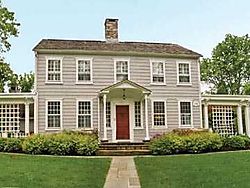
Home Structural Products & Services, Stairlifts
Structural Products & Services, Stairlifts
Furniture, Clocks,
Accessories
Antiques, Folk Art,
Fine Art, Auction Houses
ANTIQUE ABANDON
F. Scott Fitzgerald in Connecticut
By Max H. Peters


F. Scott & Zelda Fitzgerald circa 1921 in front of their Westport house, and the house today
In the mid-sixties the Westport Goodwill was in an old building on the southeast corner of Riverside Avenue and the Post Road, where an upscale gallery sits today. Back in the day this Goodwill was a Saturday hangout for bookworms from both Staples and Norwalk High. A wide selection of world literature and history was the great attraction. Paperbacks were a dime, hardcovers fifty cents. If you were down to your last quarter, as some of us carless East Norwalk boys often were, you could catch a ride with somebody to Westport and you could come out of the Goodwill with a paperback Dr. Zhivago or Lao Tzuand still have enough money left over for a Milky Way to eat on the long walk home.
On those Saturdays at the Westport Goodwill long ago there was always the same lady behind the counter. She was short, a bit stocky, with a square face, pale blue eyes, and a big grey bun at the back of her head. She would smile at you, even after you’d been loitering around the books for two hours not buying anything. Three or four of her grey-haired girlfriends would be visiting her at any time, and they would invariably start to reminisce. That’s how I learned that the saleslady was the widow of an artist. As a young married couple, she and her husband had been part of the group that caroused in the summer of 1920 with Scott and Zelda Fitzgerald at their rented Revolutionary-era house on South Compo Road. Several of her friends had been part of that scene too, and they would chime in with their own memories. After forty-five years, it was still a hot topic. It was at the Goodwill that I first heard about the time Zelda pulled a fire alarm. When the fire truck showed up and the driver yelled “Where’s the fire?” Zelda pointed to her heart and said “It’s in here.” In the decades since I heard the story at the Goodwill I’ve read it in two Fitzgerald biographies.
It’s been forty-six years since I listened to those ladies talk. In eight more years it will be a century since the Fitzgeralds lived in Westport, and it is worth noting in advance the transition in the status of their stay from vintage to antique. It was an antique abandon they embraced, and it was at Westport that it began to lose its hold. It was on Compo Road that Fitzgerald started to turn from an H.L Menken-inspired romantic cynicism towards a romantic idealism without illusions. Bound up with that was a conviction of his own literary direction, what he described as “Trying to take a piece of actuality and give it glamor from your own soul to make for that inexpressible quality it expressed in life…” The beginning of that effort, and its eventual result, is what raises the Fitzgeralds’ stay in Westport above cultural trivia. It was at Wakeman Cottage that the seeds of the magisterial compassion that came to bloom in The Great Gatsby were sown. The British critic K.G.W. Cross wrote of The Beautiful and Damned , Fitzgerald’s second novel, begun in Westport: “Although his treatment is uncertain, Fitzgerald had found his major theme—the need for illusion, and the tragedy that springs from its inevitable failure.” The house Scott and Zelda lived in for six months still stands, and it is not a stretch to call it a shrine; beyond its historical value as an authentic Colonial it is a monument to decadence redeemed by art. In an article called “Westport Wildlife” in the September 9, 1996, New Yorker, Barbara Probst Solomon makes an argument for Gatsby’s mansion being based on the building now known as the Inn at Longshore, just around the corner from Wakeman Cottage. Richard “Deej” Webb, a New Canaan high school teacher who, like Solomon, grew up on the Westport shore, has come to the same conclusion in his own research. In 2004 an article in the New York Times said there was a compelling case for Westport at least planting the Gatsby seed. Aside from the facticity of their claims, which can never be totally confirmed, Solomon and Webb have brought attention to the influence Fitzgerald’s work continues to have on the popular imagination, a magic that has increased with time.
The middle section of The Beautiful and Damned is a semi-autobiographical account of the Fitzgeralds in Westport, called Marietta in the novel. The main characters, the young couple Anthony and Gloria Patch, are fictional versions of Scott and Zelda. The Patches search for meaning comes to a head in the chapter called “Symposium,” in which Anthony’s best friend Mary Noble (based on Scott’s friend George Jean Nathan, a close associate of H.L Menken) delivers a despairing sermon one night from the top of a shed next to the Marietta train station, This comes after Gloria runs off into the night during a wild drinking party. Tracking Gloria, Fitzgerald paints us a night view of pre-suburban Westport:
She had gone some distance along the barely discernible road, probably half a mile, passed a single deserted barn that loomed up, black and foreboding, the only building of any sort between the grey house and Marietta.
…She was at the top now and could see the lands about her as successive sweeps of open country, cold under the moon, coarsely patched and seemed with thin rows and heavy clumps of trees. To her right, half a mile down the river, which trailed behind the light like the slimy path of a snail, winked the scattered lights of Marietta.
When Minnie Sayre learned that Fitzgerald was going to marry her daughter in St. Patrick’s Cathedral, she sent him a letter: “It will take more than the Pope to make Zelda good: you will have to call on the Almighty direct. “ In fact Scott, stoked with the success of his first novel, This Side of Paradise, wasjust as game as Zelda was to create what critic Lionel Trilling called a “public legend of heedlessness.” After their wedding in April, they set out to shock and mock high society in Manhattan and make sure nobody ever forgot the Fitzgeralds, and nobody has. From these first crazy weeks of their marriage came the eternal visions of Scott and Zelda riding on top of moving taxicabs, jumping into the fountain in front of the Plaza Hotel, and of Zelda in a chef’s hat doing a mad Charleston on a table at the Waldorf. In mid-May they were forcibly evicted from their suite at the Commodore Hotel. As related by biographer James R. Mellow: “Packing their bags in the Marmon, they started up the Boston Post Road in search of a home. With the luck of children in a fairy tale, they found just the cottage they were looking for...”
The Fitzgeralds were a big hit with the advance wave of New York writers, artists, and theater people already in town. It is said that during the prohibition era summers at Westport were wilder than New York. Edmund Wilson joked about finding Scott and Zelda “reveling nude in the orgies of Westport.” Mellow wrote of “the midnight swims, the mad rides along the Post Road with abrupt stops at roadhouses to replenish the supply of gin.”
But there was another side to that summer. In The Beautiful and Damned, Fitzgerald recalled that “…there were intervals of unhoped-for serenity. Close together on the porch they would wait for the moon to stream across the silver acres of farmland, jump a thick wood and tumble waves of radiance at their feet.”

